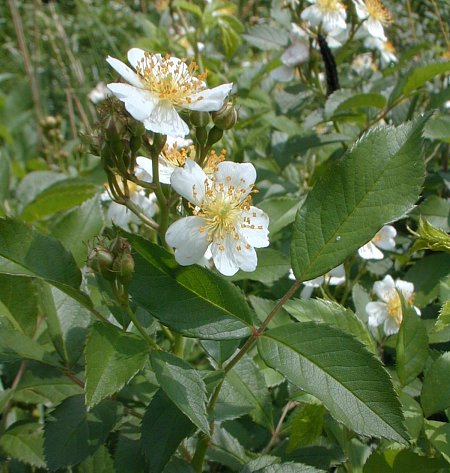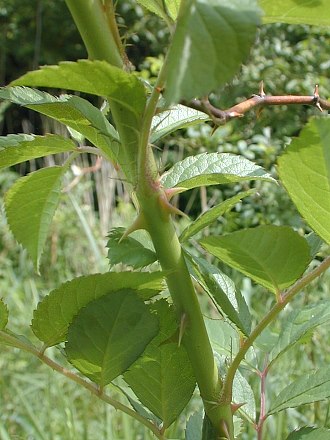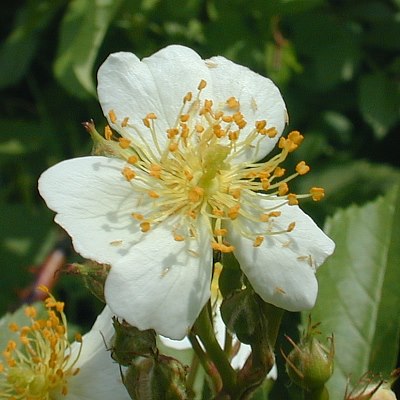Description: This perennial plant has woody stems and can assume the form of a shrub or climbing vine. In the form of a shrub it is about 3-6' tall, while as a climbing vine it gets up to 10' tall if there is other vegetation nearby to cling to. The terete hairless stems are heavily armed with stout curved thorns. They are initially green, but eventually turn brown and woody. The alternate compound leaves are odd pinnate with 5-9 leaflets (a few upper leaves may have 3 leaflets). The leaflets are up to 2½" long and ¾" across. They are medium to dark green, hairless, ovate to obovate, and serrated along their margins. At the base of the petiole of each compound leaf, there is a pair of stipules with abundant slender teeth; these teeth have a bristly appearance. This is a distinctive characteristic of Multiflora Rose.

The flowering
stalks produce an abundance of white flowers on spreading racemes or
corymbs. Each flower is about 1½" across, consisting of 5 white petals
(rarely light pink),
5 green sepals, a central column of styles, and a ring of
abundant stamens with bright yellow anthers. The blooming period occurs
during the late spring or early summer, and lasts about 3-4 weeks. The
flowers have a typical rose-like fragrance. Fertile flowers are
replaced by rather small rose hips (about ¼" across or a
little more) that turn orange-red to red with maturity. The rose hips
are globoid and hairless; they lack dried sepals at their outer tips.
The interior of each rose hip is rather dry and fleshy, where there are
several dark seeds.
Cultivation:
The preference is partial sun, mesic conditions, and fertile loamy
soil. Multiflora Rose is very aggressive and difficult to get rid of
once it becomes established. At an open sunny site, it will develop
into a shrub that produces numerous flowers, while at a shadier site
with adjacent vegetation it becomes a climbing woody vine. The leaves
are vulnerable to various kinds of foliar disease, particularly where
there is an abundance of moisture and inadequate circulation of air.
 Range
& Habitat: The non-native Multiflora
Rose is a
common plant that probably occurs in every county of Illinois. However,
it has been collected in about one-half of the counties in the state,
according to official records (see Distribution
Map). This species was
introduced into the United States by the horticulture industry from
Japan or eastern Asia after World War II, when it was advertised as a
"living fence" that would promote the privacy of residential
properties. It quickly escaped and has managed to spread with
amazing rapidity. Habitats include open deciduous woodlands, woodland
borders, thickets, weedy meadows along rivers, fence rows, powerline
clearances in wooded areas, abandoned pastures, semi-shaded areas along
roadsides, and any little-used open area that is reverting back into a
woodlands. The Multiflora Rose is a major invader of both natural and
disturbed areas.
Range
& Habitat: The non-native Multiflora
Rose is a
common plant that probably occurs in every county of Illinois. However,
it has been collected in about one-half of the counties in the state,
according to official records (see Distribution
Map). This species was
introduced into the United States by the horticulture industry from
Japan or eastern Asia after World War II, when it was advertised as a
"living fence" that would promote the privacy of residential
properties. It quickly escaped and has managed to spread with
amazing rapidity. Habitats include open deciduous woodlands, woodland
borders, thickets, weedy meadows along rivers, fence rows, powerline
clearances in wooded areas, abandoned pastures, semi-shaded areas along
roadsides, and any little-used open area that is reverting back into a
woodlands. The Multiflora Rose is a major invader of both natural and
disturbed areas.
Faunal Associations:
The abundant and showy pollen of the flowers attracts various
long-tongued bees, including honey bees and bumblebees. These insects
are the primary pollinators of the flowers. The pollen of the flowers
also attracts short-tongued Halictid bees, Syrphid flies, bee flies,
and beetles. The bees collect pollen for the larvae in their
nests or hives, while the remaining insects feed on pollen. The
flowers of most roses (Rosa spp.) do not provide nectar. Because roses
are
important in horticulture, the insect species that feed on their
foliage, flowers, and shoots are fairly well-known and
documented. These insect feeders include the larvae of shoot-boring
beetles, weevils, flea beetles, scarab beetles, aphids, armored scales,
plant bugs, larvae of sawflies, larvae of gall wasps, larvae
of
moths, grasshoppers, and thrips (see the Insect Table for
a listing of these species). Rose hips are eaten by such upland
gamebirds and songbirds as the Greater Prairie Chicken, Wild Turkey,
Ruffed Grouse, Yellow-Breasted Chat, Northern Mockingbird, Swainson's
Thrush,
and Fox Sparrow (see the Bird Table for
a more complete listing of these species). The twigs and/or foliage of
wild roses are browsed by the Domesticated Goat, White-tailed Deer,
Elk, and Cottontail Rabbit (Blackmore, 1998; Martin et al., 1951/1961;
Haugen, 1942; Myers et al., 2004; Schneider et al., 2006). The
White-footed Mouse and Deer Mouse also eat the rose hips and/or seeds
(Hamilton, 1941). The dense
foliage and prickly shoots of the Multiflora Rose provide excellent
cover and nesting
habitat for the Northern Cardinal, Brown Thrasher, Northern
Mockingbird, Field Sparrow, Veery, and other songbirds (see the
preceding Bird Table; Best, 1978; Heckscher, 2004). The birds and any
mammals that eat the rose hips help to spread the seeds of the
Multiflora Rose and other rose shrubs to new locations.

Photographic
Location:
A weedy meadow near a drainage ditch at Judge Webber Park in Urbana,
Illinois. This site received some shade from trees during the morning.
Comments:
This species produces flowers that are smaller in size, but with
greater abundance, than the native roses. It is usually quite
attractive while in full bloom. Unlike the native roses, Multiflora
Rose has stipules with bristly teeth at its petiole bases. In the
native roses, these stipules have single teeth at their outer tips that
are not bristly. The flowers of the Multiflora Rose are usually white,
while
the flowers of the native roses are usually pink. It resembles Rosa
setigera (Wild Climbing Rose) to some extent, as they both
can assume the form of a climbing vine and in the center of their
flowers there is a column of united styles. However, the Wild Climbing
Rose has compound leaves with fewer leaflets (usually 3, sometimes 5).
Like other native roses, the flowers of the Wild Climbing Rose are
larger in size and pink in color.